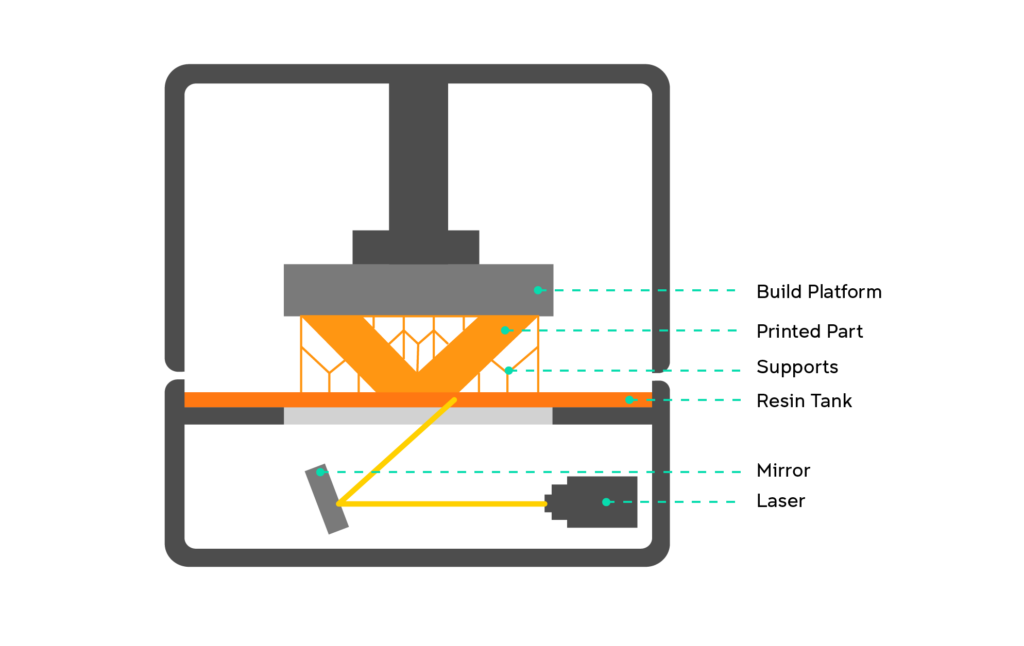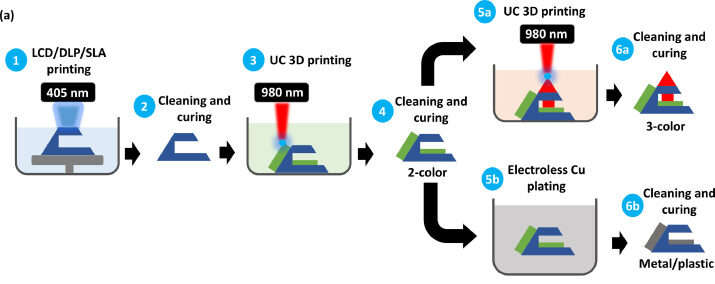Each of form of 3D printing comes with its own unique sets of advantages and disadvantages, forcing users to navigate through these tradeoffs. For instance, fused deposition modeling is known to be capable of multi-material printing but is plagued by low resolution and porosity. Stereolithography (SLA), on the other hand, offers high resolution but is currently incapable of multi-material printing.
In an effort to merge the best of both worlds, researchers from the Heriot-Watt University in Edinburgh recently published a paper in which they describe a new SLA printing technique that enables true multi-material printing.
Standard Stereolithography Printing
SLA is a form of 3D printing which works on the principle of vat photopolymerization, in which a light source (a laser, in the case of SLA) is selectively projected at a vat of liquid resin in order to cure the photopolymer into a hardened plastic. The resin used in SLA printers is a special light-reactive thermoset material that reacts with certain wavelengths of light to solidify the liquid into rigid geometries. With SLA, a stationary laser will continually cure the resin in the X and Y direction while a build platform works to raise the printed part out of the vat, enabling control over the Z dimension as well.

SLA printers use lasers to selectively cure resin. Image courtesy of UNSW Sydney.
One of the major advantages of SLA printers is that they offer extremely high resolution. Because of the laser’s precision, SLA printers are able to create prints with very fine layer lines, ranging in height from 25 to 100 microns. This results in prints with smooth surface finishes and excellent aesthetic qualities.
SLA Shortcomings
Despite the benefits of SLA printing, a notable shortcoming of the technology is its inability to support multi-material printing. In an FDM printer, switching materials mid-print is relatively straightforward, as all a user has to do is swap out one type of filament for another or rely on a machine with multiple extruders. In some cases, there are even intelligent material stations that will automatically switch filament for the user.
For SLA prints, however, the process is much more cumbersome. A standard SLA printer will consist of one tank of resin, meaning that users would have to switch the resin in the tank mid-print to attempt multi-material printing. This is not feasible in practice, however, as the viscosity of the resin results in cross-contamination, and the resin-swapping process would result in the introduction of air bubbles into the printer.
New Research
While techniques for multi-material SLA printing have been presented before, and some have even received significant funding, none have reached the market yet. The latest development from Heriot-Watt enables true multi-material fabrication with SLA.
As described in the team’s recently published paper in Applied Materials Today, the crux of the new discovery revolves around the use of specially engineered resins that contain nanoparticles that support the process of optical upconversion. Optical upconversion is a property in which a material’s response to light is not linearly related to the light’s intensity. In the context of this research, optical upconversion means that the laser’s light will only cure the resin at the point of the laser’s focus.

A schematic representation of the multi-material process. Image courtesy of Zhakeyev et al.
By using resin materials that exhibit optical upconversion, the researchers were able to cure material deeper in the resin vat than otherwise possible. Whereas conventional SLA printers have a depth limit of 0.1mm, the new technique has a depth limit of over 5.0cm.

Thanks to this improved depth limit, the researchers have paved a way to print in SLA with multi-materials by solidifying one material at certain depths, and then later adding a second material and solidifying that material at a different depth. In this way, the new research enables the printing of multiple materials in the same sample – resulting in true multi-material SLA printing.
A Viable Solution?
Many other multi-material SLA printing solutions have been proposed in the past, but still, nothing has proven to be commercially viable yet. With the new research from Heriot-Watt University, the team believes they’ve finally found a solution to affordable and commercially viable multi-material printing. While the results look promising, only time will really tell if this is the solution the industry has been waiting for.
Subscribe to Our Email Newsletter
Stay up-to-date on all the latest news from the 3D printing industry and receive information and offers from third party vendors.
You May Also Like
3D Printing News Briefs, April 27, 2024: Research, Digital Dentistry, Cycling, & More
We’re starting today’s 3D Printing News Briefs with some research into 3D printed luminescent quantum-dot polymer architectures and free-form laser beam shaping, and then on to an open source 4-axis...
HP & INDO-MIM Collaborate to Boost Metal 3D Printing in India
HP Inc. and INDO-MIM, a US- and India-based supplier of metal injection molding (MIM) powders and contract manufacturer, have announced that the two companies will collaborate to accelerate additive manufacturing...
3D Printing News Briefs, February 17, 2024: Shot Blasting, Service Bureaus, & More
In today’s 3D Printing News Briefs, we’re starting out with post-processing, as SKZ Würzburg is using a shot blast system from AM Solutions for its research. Moving on to business,...
3D Printing News Unpeeled: Not That Kind of Organ 3D Printing
GKN Aerospace will create a 150 jobs in Trollhattan Sweden with an investment of $60 million part of which comes from the Swedish Energy Agency’s Industriklivet initiative. The investment will...






























